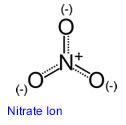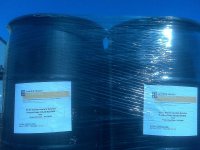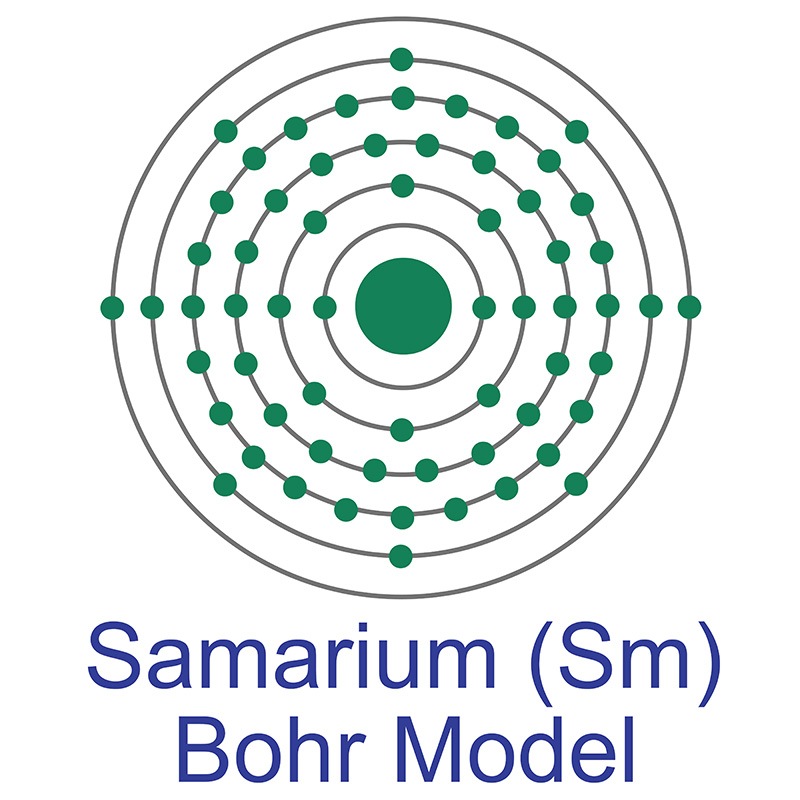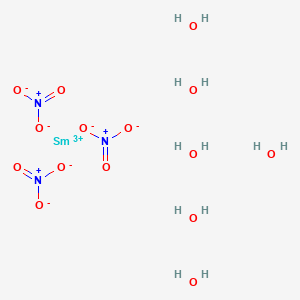SECTION 1. IDENTIFICATION
Product Name: Samarium Nitrate Solution
Product Number: All applicable American Elements product codes, e.g. SM-NAT-02-SOL
, SM-NAT-03-SOL
, SM-NAT-04-SOL
, SM-NAT-05-SOL
CAS #: 13759-83-6
Relevant identified uses of the substance: Scientific research and development
Supplier details:
American Elements
10884 Weyburn Ave.
Los Angeles, CA 90024
Tel: +1 310-208-0551
Fax: +1 310-208-0351
Emergency telephone number:
Domestic, North America: +1 800-424-9300
International: +1 703-527-3887
SECTION 2. HAZARDS IDENTIFICATION
Classification of the substance or mixture
Classification according to Regulation (EC) No 1272/2008
GHS03 flame over circle
Ox. Liq. 2
H272 May intensify fire; oxidiser.
GHS05 corrosion
Skin Corr. 1B H314 Causes severe skin burns and eye damage.
Other hazards that do not result in classification
No information known.
Label elements
Labelling according to Regulation (EC) No 1272/2008
The substance is classified and labelled according to the CLP regulation.
Hazard pictograms


GHS03 GHS05
Signal word
Danger
Hazard statements
H272 May intensify fire; oxidiser.
H314 Causes severe skin burns and eye damage.
Precautionary statements
P221 Take any precaution to avoid mixing with combustibles.
P210 Keep away from heat, hot surfaces, sparks, open flames and other ignition sources. No smoking.
P303+P361+P353 IF ON SKIN (or hair): Take off immediately all contaminated clothing. Rinse skin with water/shower.
P305+P351+P338 IF IN EYES: Rinse cautiously with water for several minutes. Remove contact lenses, if present and easy to do. Continue rinsing.
P405 Store locked up.
P501 Dispose of contents/container in accordance with local/regional/national/international regulations.
Other hazards
Results of PBT and vPvB assessment
PBT: Not applicable.
vPvB: Not applicable
SECTION 3. COMPOSITION/INFORMATION ON INGREDIENTS
Chemical characterization: Substances
(CAS#) Description:
Samarium nitrate (CAS# 13759-83-6 )
Water (CAS# 7732-18-5)
SECTION 4. FIRST AID MEASURES
Description of first aid measures General information Immediately remove any clothing soiled by the product. After inhalation
Supply fresh air. If required, provide artificial respiration. Keep patient warm. Seek immediate medical advice.
After skin contact
Immediately wash with water and soap and rinse thoroughly. Seek immediate medical advice.
After eye contact Rinse opened eye for several minutes under running water. Then consult a doctor. After swallowing Seek immediate medical advice.
SECTION 5. FIREFIGHTING MEASURES
Extinguishing media
Suitable extinguishing agents
Product is not flammable. Use fire fighting measures that suit the surrounding fire.
Special hazards arising from the substance or mixture
This substance is an oxidizer and its heat of reaction with reducing agents or combustibles may cause ignition.
Advice for firefighters
Protective equipment:
Wear self-contained respirator.
Wear fully protective impervious suit.
SECTION 6. ACCIDENTAL RELEASE MEASURES
Personal precautions, protective equipment and emergency procedures
Wear protective equipment. Keep unprotected persons away.
Ensure adequate ventilation
Environmental precautions:
Do not allow material to be released to the environment without proper governmental permits.
Methods and material for containment and cleaning up:
Use neutralizing agent.
Dispose contaminated material as waste according to item 13.
Ensure adequate ventilation.
Absorb with liquid-binding material.
Reference to other sections
See Section 7 for information on safe handling
See Section 8 for information on personal protection equipment.
See Section 13 for disposal information.
SECTION 7. HANDLING AND STORAGE
Handling
Precautions for safe handling
Keep container tightly sealed.
Store in cool, dry place in tightly closed containers.
Ensure good ventilation at the workplace.
Information about protection against explosions and fires:
Substance/product can reduce the ignition temperature of flammable substances. This substance is an oxidizer and its heat of reaction with reducing agents or combustibles may cause ignition.
The product is not flammable
Conditions for safe storage, including any incompatibilities
Storage
Requirements to be met by storerooms and receptacles: No special requirements.
Information about storage in one common storage facility:
Store away from flammable substances.
Store away from reducing agents.
Aqueous solutions are incompatible with alkali and alkaline earth metals and many reactive organic and inorganic chemicals.
Further information about storage conditions:
Keep container tightly sealed.
Store in cool, dry conditions in well sealed containers.
SECTION 8. EXPOSURE CONTROLS/PERSONAL PROTECTION
Exposure controls
Personal protective equipment
General protective and hygienic measures
The usual precautionary measures for handling chemicals should be followed.
Keep away from foodstuffs, beverages and feed.
Remove all soiled and contaminated clothing immediately.
Wash hands before breaks and at the end of work.
Avoid contact with the eyes and skin.
Breathing equipment: Use suitable respirator when high concentrations are present.
Protection of hands: Impervious gloves
Eye protection:
Safety glasses
Tightly sealed goggles
Full face protection
Body protection: Protective work clothing.
SECTION 9. PHYSICAL AND CHEMICAL PROPERTIES
Information on basic physical and chemical properties
General Information
Appearance:
Form: Solution
Color: Colorless
Odor: Odorless
Odour threshold: Not determined.
pH-value: Not determined.
Change in condition
Melting point/Melting range: Not determined
Boiling point/Boiling range: Not determined
Sublimation temperature / start: Not determined
Flash point: Not applicable
Not determined
Flammability (solid, gaseous) Not applicable.
Ignition temperature: Not determined
Decomposition temperature: Not determined
Auto igniting: Not determined.
Explosion limits:
Lower: Not determined
Upper: Not determined
Vapor pressure: Not determined
Relative density Not determined.
Vapour density Not determined.
Evaporation rate Not determined.
Solubility in / Miscibility with
Water: Fully miscible
Segregation coefficient (n-octonol/water): Not determined.
Viscosity:
dynamic: Not determined.
kinematic: Not determined.
Other information No further relevant information available.
SECTION 10. STABILITY AND REACTIVITY
Reactivity
Chemical stability
Thermal decomposition / conditions to be avoided:
Decomposition will not occur if used and stored according to specifications.
Possibility of hazardous reactions
Reacts with alkali metals.
Reacts with reducing agents
Reacts with flammable substances
Reacts with alkaline earth metals.
Incompatible materials:
Aqueous solutions are incompatible with alkali and alkaline earth metals and many reactive organic and inorganic chemicals.
Hazardous decomposition products: Nitrogen oxides
SECTION 11. TOXICOLOGICAL INFORMATION
Information on toxicological effects
Acute toxicity:
LD/LC50 values that are relevant for classification:
Oral: LDLo: 430 mg/kg (hmn)(HNO3)
Unreported: LDLo: 110 mg/kg (man)(HNO3)
Primary irritant effect:
on the skin: Corrosive effect on skin and mucous membranes.
on the eye: Strong corrosive effect.
Sensitization: No sensitizing effects known.
Subacute to chronic toxicity:
Nitric acid is a corrosive oxidizing acid. The liquid causes burns on contact. Eye contact may cause blindness. Vapors are irritating and cause upper respiratory irritation which may be severe. Corrosive to the teeth and digestive tract on ingestion. Dilute solutions have reduced effects.
Cerium salts increase the blood coagulation rate. Exposure to cerium salts may increase sensitivity to heat, itching and skin lesions. Large doses to experimental animals have caused writhing, ataxia, labored respiration, sedation, hypotension and death by cardiovascular collapse.
Additional toxicological information:
Swallowing will lead to a strong corrosive effect on mouth and throat and to the danger of perforation of esophagus and stomach.
To the best of our knowledge the acute and chronic toxicity of this substance is not fully known.
No classification data on carcinogenic properties of this material is available from the EPA, IARC, NTP, OSHA or ACGIH.
SECTION 12. ECOLOGICAL INFORMATION
Toxicity
Acquatic toxicity: No further relevant information available.
Persistence and degradability No further relevant information available.
Behavior in environmental systems:
Bioaccumulative potential No further relevant information available.
Mobility in soil No further relevant information available.
Additional ecological information:
General notes:
Do not allow undiluted product or large quantities of it to reach ground water, water course or sewage system.
Do not allow material to be released to the environment without proper governmental permits.
Results of PBT and vPvB assessment
PBT: Not applicable.
vPvB: Not applicable.
Other adverse effects No further relevant information available.
SECTION 13. DISPOSAL CONSIDERATIONS
Waste treatment methods
Recommendation Consult state, local or national regulations to ensure proper disposal.
Uncleaned packagings:
Recommendation: Disposal must be made according to official regulations.
Recommended cleansing agent: Water, if necessary with cleansing agents.
SECTION 14. TRANSPORT INFORMATION
DOT regulations:
Hazard class: 5.1
Identification number: UN3218
Packing group: III
Proper shipping name (technical name): NITRATES, INORGANIC, AQUEOUS SOLUTION, N.O.S.
Label 5.1
Land transport ADR/RID (cross-border)
ADR/RID class: 5.1 (O1) Oxidizing substances
Danger code (Kemler): 50
UN-Number: 3218
Packaging group: III
UN proper shipping name: 3218 NITRATES, INORGANIC, AQUEOUS SOLUTION, N.O.S.
Maritime transport IMDG:
IMDG Class: 5.1
UN Number: 3218
Label 5.1
Packaging group: III
Marine pollutant: No
Proper shipping name: NITRATES, INORGANIC, AQUEOUS SOLUTION, N.O.S.
Air transport ICAO-TI and IATA-DGR:
ICAO/IATA Class: 5.1
UN/ID Number: 3218
Label 5.1
Packaging group: III
Proper shipping name: NITRATES, INORGANIC, AQUEOUS SOLUTION, N.O.S.
UN "Model Regulation": UN3218, NITRATES, INORGANIC, AQUEOUS SOLUTION, N.O.S., 5.1, III
Special precautions for user Warning: Oxidizing substances
Transport in bulk according to Annex II of MARPOL73/78 and the IBC Code Not applicable.
SECTION 15. REGULATORY INFORMATION
Safety, health and environmental regulations/legislation specific for the substance or
mixture
Product related hazard informations:
Hazard symbols:
C Corrosive
O Oxidizing
Risk phrases:
8 Contact with combustible material may cause fire.
34 Causes burns.
Safety phrases:
17 Keep away from combustible material.
26 In case of contact with eyes, rinse immediately with plenty of water and seek
medical advice.
36/37/39 Wear suitable protective clothing, gloves and eye/face protection.
45 In case of accident or if you feel unwell, seek medical advice immediately.
National regulations
All components of this product are listed in the U.S. Environmental Protection Agency Toxic Substances Control Act Chemical substance Inventory.
All components of this product are listed on the Canadian Non-Domestic Substances List (NDSL).
Information about limitation of use:
For use only by technically qualified individuals.
This product is subject to the reporting requirements of section 313 of the Emergency
Planning and Community Right to Know Act of 1986 and 40CFR372.
Chemical safety assessment: A Chemical Safety Assessment has not been carried out.
SECTION 16. OTHER INFORMATION
Safety Data Sheet according to Regulation (EC) No. 1907/2006 (REACH). The above information is believed to be correct but does not purport to be all inclusive and shall be used only as a guide. The information in this document is based on the present state of our knowledge and is applicable to the product with regard to appropriate safety precautions. It does not represent any guarantee of the properties of the product. American Elements shall not be held liable for any damage resulting from handling or from contact with the above product. See reverse side of invoice or packing slip for additional terms and conditions of sale. COPYRIGHT 1997-2022 AMERICAN ELEMENTS. LICENSED GRANTED TO MAKE UNLIMITED PAPER COPIES FOR INTERNAL USE ONLY.

 materials. American Elements can prepare dissolved homogeneous solutions at customer specified concentrations or to the maximum stoichiometric concentration. Packaging is available in 55 gallon drums, smaller units and larger liquid totes. American Elements maintains
materials. American Elements can prepare dissolved homogeneous solutions at customer specified concentrations or to the maximum stoichiometric concentration. Packaging is available in 55 gallon drums, smaller units and larger liquid totes. American Elements maintains  The number of electrons in each of samarium's shells is 2, 8, 18, 24, 8, 2 and its electron configuration is [Xe]4f6 6s2. The samarium atom has a radius of 180 pm and a Van der Waals radius of 229 pm. In its elemental form, samarium has a silvery-white appearance.
The number of electrons in each of samarium's shells is 2, 8, 18, 24, 8, 2 and its electron configuration is [Xe]4f6 6s2. The samarium atom has a radius of 180 pm and a Van der Waals radius of 229 pm. In its elemental form, samarium has a silvery-white appearance.  Samarium is not found as free element in nature. It is found in the minerals cerite, gadolinite, samarskite, monazite and bastnäsite. Samarium is classified as a
Samarium is not found as free element in nature. It is found in the minerals cerite, gadolinite, samarskite, monazite and bastnäsite. Samarium is classified as a 
